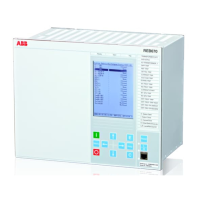other fault types this value must be multiplied by a coefficient shown in the Table 24 in
order to calculate the actual primary pickup value.
Table 24: Pickup coefficients for Summated Differential Protection
Type of fault A-Gnd B-Gnd C-Gnd A-B BC C-A ABC
ASCT end
connected
0.434 0.578 0.867 1.732 1.732 0.867 1.0
ASCT series
connected
1.732 0.867 0.578 1.732 1.732 0.867 1.0
The coefficients in Table 24 are only relevant for ideal internal faults
(that is, load currents do not exist in the healthy phases).
Example 1:
The minimal differential operating current level in the IED is set to 1250A. All ASCTs
are series connected. What is the theoretical primary
pickup value in case of C-Gnd
fault?
Answer 1:
According to Table
24, pickup coefficient for this type of ASCT connection and this
type of fault is 0.578. Therefore:
I
Pickup
L3 Gnd–( ) 0.578 1250× 722.5A= =
EQUATION1106 V1 EN-US (Equation 11)
( ) 0.578 1250 722.5
Pickup
I C Gnd A- = × =
EQUATION1784 V1 EN-US (Equation 11)
This means that if 722.5 primary amperes is injected only in phase C of any of the
connected main CTs, the IED shall display the dif
ferential current of 1250A (primary)
and should be on the point of the pickup (that is, trip).
SEMOD127594-37 v4
In addition to busbar protection differential zones, the IED can incorporate other
additional functions and features. If and how they can be used together with summation
busbar protection design is shown in Table
25:
Section 6 1MRK 505 370-UUS A
Differential protection
170 Busbar protection REB670 2.2 ANSI
Application manual

